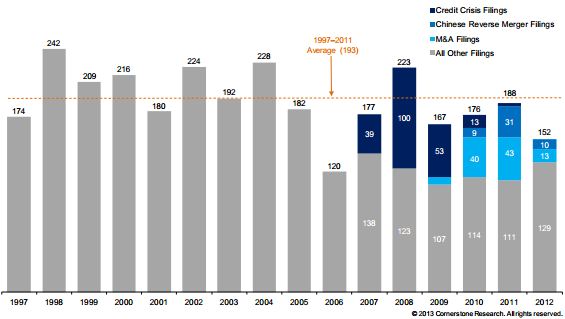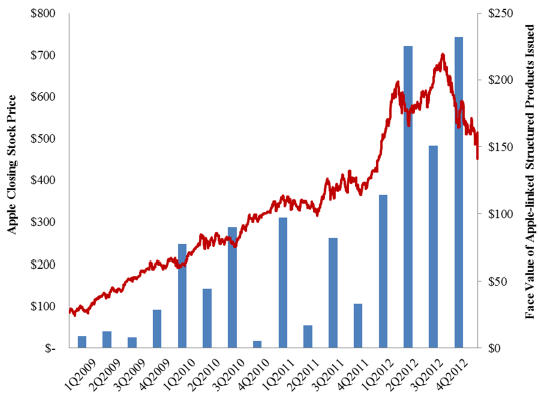Investors Returning to Capital-at-Risk Products
(May 2013)
Yakob Peterseil of Risk.net recently noted that "[b]anks are boosting issuance of leveraged notes linked to US equity indexes and notes that pay out when yield curves steepen." According to the article, reverse convertibles and buffered notes are seeing a resurgence as investors begin to be more optimistic about stock market growth. In addition, principal-protected structures like structured certificates of deposit and principal-protected notesare falling out of favor as attractive terms are...
Update on Apple-Linked Structured Products
(May 2013)
A few months ago, SLCG issued a working paper that studied the decline in value of Apple-linked structured products. Jason Zweig of the Wall Street Journal also wrote a piece about these findings, most notably that Apple's stock price decline had serious repercussions in the structured product market. Apple's stock price has continued to fall and we recently updated the paper to show how this decline is still affecting investors in structured products.*
Since reaching $700 in September of...
Resurgence of Commercial Mortgage Backed Securities and Decreased Underwriting Standards
(Apr 2013)
Late last week, Reuters reported that the issuance of so-called 'large-loan' Commercial Mortgage Backed Securities (CMBS) has recently spiked and that the increase in volume may be due in part to more lenient underwriting standards. Large-loan CMBS issuance in the first few months of 2013 has already surpassed that of 2012.
CMBSs are created by securitizing a pool of commercial mortgage loans such that an investment in a CMBS is a claim on the future cashflows from the pool of commercial...
Are ETF Flows Costly to ETF Investors?
(Apr 2013)
Exchange-traded funds (ETFs) are often lauded for their ability to efficiently create or redeem shares in response to changes in demand for the fund (known as fund flows). However, new research suggests that some ETFs that hold international securities may face transactional frictions that prevent them from tracking their benchmarks as well as other ETFs.
When there is an imbalance between supply and demand for an ETF, authorized participants (APs) create or redeem shares of the ETF to...
Securities Class Action Filings Decrease in 2012
(Feb 2013)
Earlier this year, Cornerstone Research released 2012 review of Securities Class Action Filings in conjunction with the Stanford Law School -- see the press release. The report notes that the number of federal securities class action filings have decreased in recent years and, in particular, has fallen nearly 20% from 2011 to 2012. For the number of filings over the past sixteen years can be found below (Figure 2 in their report).
Cornerstone attributes the majority of the decline in class...
FTC Releases Report on Debt Buying Industry
(Feb 2013)
The Federal Trade Commission (FTC) released their report yesterday on the "Structures and Practices of the Debt Buying Industry". This rather lengthy report brings into focus the industry -- debt collection and debt buying -- that is responsible for more consumer complaints than any other industry.
"Debt buying" is the practice of purchasing debts from creditors. A creditor may decide that it is unlikely the debtor will repay a debt and as a result may sell the rights to collect the debt for...
Apple's Declining Stock Price and Structured Products
(Jan 2013)
Jason Zweig at the Wall Street Journal has an excellent piece on a part of the Apple story that hasn't gotten much press: many equity-linked structured products are linked to the common stock of Apple.
SLCG has recently completed an analysis of the market value of outstanding structured products linked to Apple common stock (AAPL). In the following figure, we plot the total quarterly issuance of AAPL-linked structured products in our database since the first quarter of 2009.
As Apple's common...


